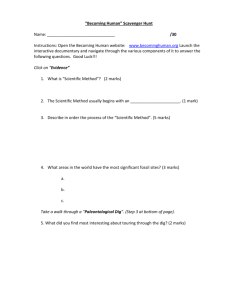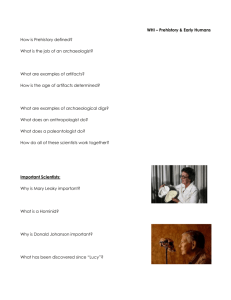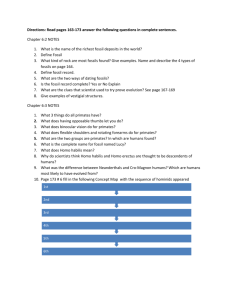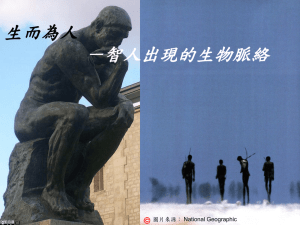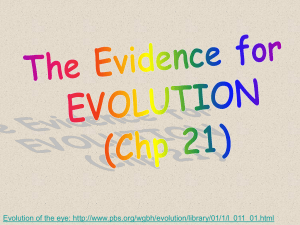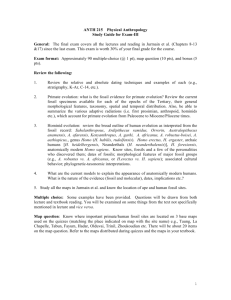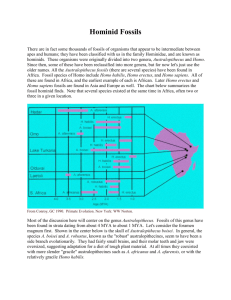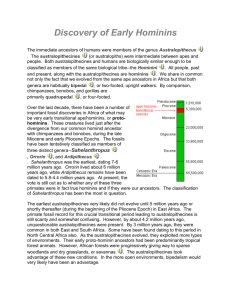2010 SEM 1 Exam (evolution component)
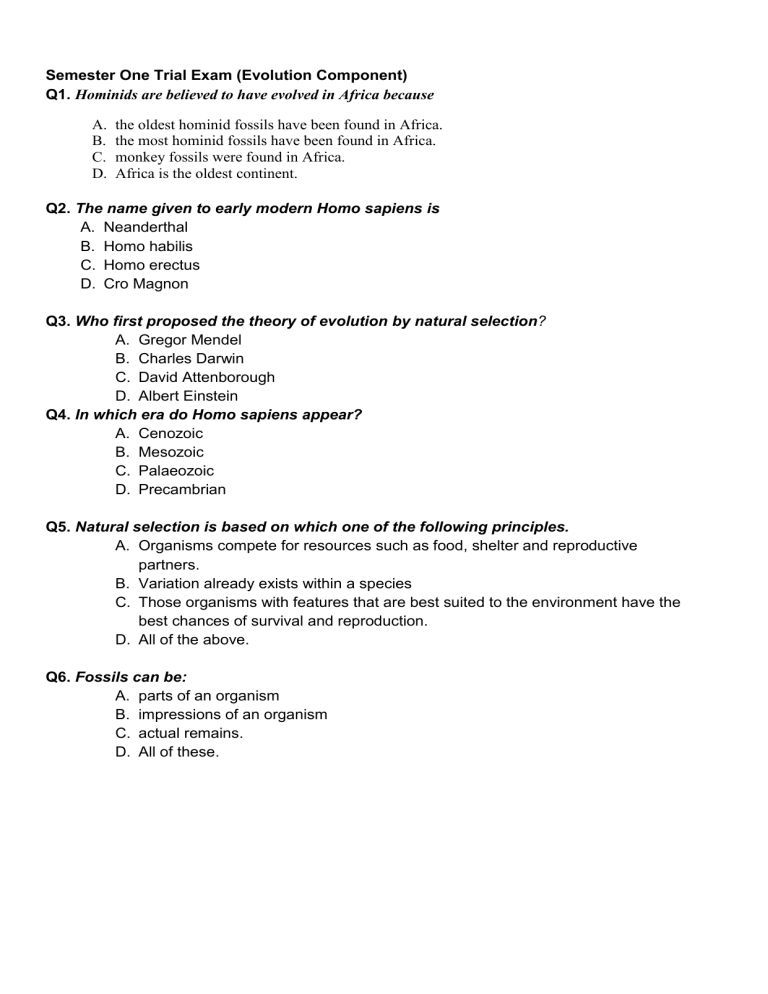
Semester One Trial Exam (Evolution Component)
Q1.
Hominids are believed to have evolved in Africa because
A.
the oldest hominid fossils have been found in Africa.
B.
the most hominid fossils have been found in Africa.
C.
monkey fossils were found in Africa.
D.
Africa is the oldest continent.
Q2.
The name given to early modern Homo sapiens is
A. Neanderthal
B. Homo habilis
C. Homo erectus
D. Cro Magnon
Q3.
Who first proposed the theory of evolution by natural selection?
A. Gregor Mendel
B. Charles Darwin
C. David Attenborough
D. Albert Einstein
Q4.
In which era do Homo sapiens appear?
A. Cenozoic
B. Mesozoic
C. Palaeozoic
D. Precambrian
Q5.
Natural selection is based on which one of the following principles.
A. Organisms compete for resources such as food, shelter and reproductive partners.
B. Variation already exists within a species
C. Those organisms with features that are best suited to the environment have the best chances of survival and reproduction.
D. All of the above.
Q6.
Fossils can be:
A. parts of an organism
B. impressions of an organism
C. actual remains.
D. All of these.
Q7.
The drawing shows some fossil layers that were uncovered.
Which of the following sequences could have produced the layers of fossils shown?
A. A river valley flooded and then dried out again.
B. Falling sea levels resulted in a forest replacing an ocean.
C. Drought caused a lake to dry out and become a grassland.
D. Rising sea levels meant a forest was flooded by the ocean.
Q8.
Biogeography is one line of evidence that supports the theory of evolution. Which of the following is an example of how biogeography supports evolution?
A. The hind limb bones of vertebrates can be shown to have come from a common ancestor.
B. Pythons have hind limb bones that have lost their function.
C. Flightless birds such as emus and ostriches are only found in the southern hemisphere.
D. The DNA of humans and chimpanzees is very similar.
For questions 9-11
The diagram below represents three rock faces from three different localities. Fossils have been identified in each rock layer. Some fossils were found to be common to two or three localities .
Year 10 Science Exam 1
Q9. How many different types of fossils were identified?
A. 4
B. 5
C. 7
D. 11
Q10. Which rock layers in the three different localities are the same age?
A. Rock layers 3,7 and 10
B. Rock layers 1,4 and 8
C. Rock layers 3,4 and 9
D. Rock layers 1,7 and 9
Q11. Which one of the following is the oldest fossil? (Assume that the rock layers are in the original order in which they were laid down.)
Use the following diagram to answer questions Q12 to Q14.
The diagram below shows one view of human evolution.
Q12.
According to this diagram, which is not a true ancestor of Homo sapiens?
A. H. neanderthalensis
B. H.heidelbergensis
C. H.ergaster.
D. H.habilis.
Q13.
According to this diagram, the greatest number of different
hominids existed about
A. one million years ago.
B. two million years ago.
C. three million years ago.
D. four million years ago.
Year 10 Science Exam 2
Q14.
According to this diagram, which hominid co-existed with Homo sapiens?
A. H. rudolfensis.
B. P. boisei
C. H. neanderthalensis
D. H. heidelbergensis
Q15.
The most likely name for the hominid labelled
“A” is
A B
C D
A. Homo habilis
B. Neanderthal
C. Homo sapiens
D. Australopithecus afarensis
Q16.
Which molecule is used to determine the degree of relatedness between different species?
A. Water
B. DNA
C. Glucose
D. Carbohydrate
Q17.
Comparative embryology shows
A. mutations in embryos.
B. similarities among structures in embryos of different species.
C. the genetic makeup of embryos.
D. similarities between limbs.
Year 10 Science Exam 3
Q18.
The following diagram shows the structure of limbs of different species of animals.
Observations of structures such as these can be used by scientists to theorise which species have common ancestors. This type of evidence is known as
A. comparative embryology.
B. fossils.
C. comparative anatomy.
D. DNA hybridisation.
Q19.
Which is the process where humans breed animals and plants for desired
characteristics?
A. DNA hybridisation.
B. Artificial selection.
C. Natural selection.
D. Speciation.
Q20.
The wings of birds and butterflies are ____________ structures.
A. homologous.
B. analogous.
C. complimentary.
D. similar.
Q21.
Which of the following is the most subscribed to hypothesis regarding why
hominids began walking upright?
A. It served to keep them warmer.
B. It enabled efficient movement over long distances?
C. It freed the hands for foraging.
D. It was a mating behaviour.
Year 10 Science Exam 4
Q22.
Which of the following statements is false?
A. Evidence suggests that brains of hominids got bigger over time.
B. Evidence suggests that Australopithecus groups belong to the same species as Homo groups.
C. Evidence suggests that Neanderthals lived side by side with modern man for a brief period.
D. Evidence suggests that human beings and chimps share a common ancestor.
Q23.
Although the theory of evolution by natural selection cannot be proven, there is a substantial body of evidence that supports it. Which of the following ideas can be
explained by this theory?
A. Why species change over time.
B. How individuals reproduce.
C. What a species will look like in the future.
D. Where unrelated species exist.
Q24.
Sharks and dolphins share similar features but also have essential differences.
The information in the table suggests
A. Fish evolved from mammals.
B. That the similarities between sharks and dolphins evolved by chance due to the similar environment they live in.
C. Sharks and dolphins are geographically isolated.
D. Sharks act as a selective pressure on dolphins. text
Year 10 Science Exam 5
Section B. Short Answer questions
.
Complete answers and working in the spaces provided.
Question 1 .
A particular species of lizard comes in two main colours- grey and sandy. A biologist was investigating whether natural selection favoured a certain colour in two different habitats. In each habitat, she marked 100 of each colour type and released them. Two weeks later, she counted the number of each colour type that was still alive in each of the two habitats. Her results for the experiment are shown in the following table.
Start Of Experiment End Of Experiment
Number of
Grey Lizards
Number of
Sandy Lizards
Number of
Grey Lizards
Number of
Sandy
Lizards
62 Habitat One
Habitat Two
100
100
100
100
94
66 96 a. What lizard colour appears to be favoured in i. Habitat One? ___________________________ (1 mark) ii. Habitat Two? ___________________________ (1 mark) b. Small hawks feed on these lizards. Suggest how sandy coloured lizards might be better adapted than grey lizards if they are both living in an area where these hawks are found.
_____________________________________________________________________
_____________________________________________________________________
_____________________________________________________________________
_____________________________________________________________________
_____________________________________________________________________
(2 marks) c. Six months later, the biologist noted that were was a black coloured lizard in one of the two habitats. Explain how this new colour of lizard might have come about.
____________________________________________________________________
____________________________________________________________________
(1 mark)
Year 10 Science Exam 6
Total = 5 marks
Question 2 . Read the following news article on human evolution.
Fossil find could be “missing link” to humans by Matthew Allen (April, 2010)
The discovery of a near perfect ancient fossil skeleton may prove to be a vital piece in the jigsaw to discovering the roots of modern humans. A team of researchers from Zurich
University helped to uncover the skeletons in South Africa that are said to be between 1.78 and
1.95 million years old. The find could re-write the history of human evolution.
At least five skeletons – two of them nearly perfectly formed – have so far been excavated from caves, with signs that there could be more. The newly discovered part ape, part human species has been named Australopithecus sebida . The find has been hailed as the most significant since the skeleton of a three-million-yearold specimen, dubbed “Lucy”, was unearthed in Ethiopia in 1974. But while Lucy was ape-like, Australopithecus sebida could stand on two legs and has other human-like features.
“To call Lucy the ‘missing link’ between apes and humans is a bad definition,” Peter Schmid, from
Zurich University’s anthropology department said. “The new find is a real link in the chain between Lucy and modern humans. It could be a real key in understanding the immediate ancestor before the genus,
Homo .”
The first bone was discovered by chance in 2008 after miners uncovered the site in the Malapa cave, situated on a game reserve north of Johannesburg. But the true importance of the find has only been put into perspective after two years of painstaking excavation and research. The bodies appear to have sunk quickly into the mud in the remote and sheltered spot. The remains were so well preserved that two skeletons – that of a young male and an adult female – were uncovered almost intact.
“We found preserved plant material among the bones and a tooth on one skeleton still had food remains on it,” said Schmid. “The levels of conservation were extraordinary; it is one of the most complete fin ds ever.” “Dead bodies usually lay on the ground after death, exposed to the elements and wild animals, until even the bone deteriorates.”
With such complete skeletons, researchers were able to piece together how Australopithecus sebida moved and lived. The strong, curved fingers, long arms and flexible feet suggested it was adapted for climbing. But the length and structure of the leg bones also points to the species being able to stand upright on two legs.
“It quickly became apparent that the discovery was something new, unlike any remains previously found,” said Schmid, who was called in to examine the fossils along with other leading international experts. “It has a real mosaic of characteristics.”
It is now up to anthropologists to decide where Australopithecus sebida fits into the evolutionary scale and to determine if it is a direct ancestor of humans.
Australopithecines roamed Africa between four million years ago and around 1.4 million years ago when they became extinct. But the new specimen may yet have closer links to the Homo genus that includes modern humans.
“We may have to rethink a lot of our previous work,” said Schmid. “Lots of candidates for the missing link between apes and humans have been put forward before. They have usually been individual bones, but now we have complete skeletons, so we have a lot more to work with.”
In the meantime, the cave excavation work continues with the promise of finding yet more fossilized
Year 10 Science Exam 7
remains. For Schmid, the chance to take part in the groundbreaking discovery came because his team was already working on a nearby archaeological site. a. Explain why the fossil specimens of Australopithecus sebida were so well preserved.
__________________________________________________________________________
__________________________________________________________________________
__________________________________________________________________________
__________________________________________________________________________
__________________________________________________________________________
(2 marks) b. What is meant by the term “Missing Link?”
_________________________________________________________________________
_________________________________________________________________________
_________________________________________________________________________
(1 mark) c. Suggest the probable diet of Australopithecus sebida .
Justify your answer.
_________________________________________________________________________
_________________________________________________________________________
_________________________________________________________________________
_________________________________________________________________________
_________________________________________________________________________
(2 marks) d. Apart from being able to stand upright, suggest two other traits that Australopithecus sebida probably possessed that made it more human-like than other Australopithecines, such as Lucy.
Trait 1 _________________________________________________________________________
_______________________________________________________________________________
Trait 2 _________________________________________________________________________
Year 10 Science Exam 8
_______________________________________________________________________________
(2 marks) e. How would the curved fingers of Australopithecus sebida be useful when climbing?
_________________________________________________________________________
_________________________________________________________________________
(1 mark) f . Given that the fossil is so well preserved, some scientists are hoping that some DNA may be found in the fossil. Why would preserved DNA be useful?
_________________________________________________________________________
_________________________________________________________________________
_________________________________________________________________________
(1 mark)
The picture below shows the fossilised skull of one of the specimens. g. What can be inferred about the vision of Australopithecus sebida from this fossil. Justify your answer.
_________________________________________________________________________
_________________________________________________________________________
_________________________________________________________________________
_________________________________________________________________________
_________________________________________________________________________
(2 marks)
Total = 11 marks
Year 10 Science Exam 9
Question 3 .
The picture below shows the relationship of modern dogs to wolves. a. Name the process that has produced the wide variety of types seen in modern dogs.
_________________________________________________________________ (1 mark) b. All domestic dogs belong to the same species, Canis familiaris . What feature characterises all members of the same species.
___________________________________________________________________________
___________________________________________________________________________
(1 mark)
The diagram below shows 4 animals that have evolved separately in different parts of the world. Each has a diet consisting largely of termites and ants.
Year 10 Science Exam 10
c. Briefly describe two adaptations to a diet of termites and ants that these organisms possess. In your answer describe how these adaptations are used.
1. ________________________________________________________________________
___________________________________________________________________________
2. _________________________________________________________________________
___________________________________________________________________________
(2 marks) d. Name the evolutionary process that has resulted in the similar adaptations possessed by these animals.
___________________________________________________________ (1 mark)
Total = 5 marks
Question 4 .
On an island off the coast of New Zealand, a particular species of plant exists in two forms.
One form has sharp spines on its stems while the other lacks spines and has smooth stems.
Before Europeans came to the area, most of the plants had smooth non-spiny stems and only a few possessed spiny stems. About 100 years ago, goats were introduced to the island and began feeding on the plants. Last year, a biologist visited the island and observed that 90% of the plants had spiny stems and only 10% had smooth stems.
Explain how natural selection could bring about this change.
_________________________________________________________________________
_________________________________________________________________________
_________________________________________________________________________
_________________________________________________________________________
_________________________________________________________________________
_________________________________________________________________________
_________________________________________________________________________
_________________________________________________________________________
_________________________________________________________________________
_________________________________________________________________________
(4 marks)
Total = 4 marks
Year 10 Science Exam 11



